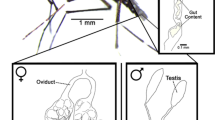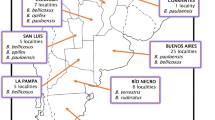Abstract
Environmental changes such as global warming and biological invasion caused by human activities raise the possibility of secondary contact between the endangered butterfly species Zizina emelina and its sibling species Zizina otis in Japan. To assess the possible risks from their habitats overlapping, we investigated the potential for hybridization and the development of F1 individuals. We observed successful mating of the two sibling species under artificial conditions. The presence of a postzygotic hybridization barrier was supported by the delay of larval development only in females; a delay did not occur in males. Existence of the barrier was also supported by a decreased egg hatching rate in one brood; this was likely associated with infection with Wolbachia, a bacterium manipulating the reproductive capability of its host. The size and wing markings of F1 hybrid individuals were intermediate between those of the two species. These results suggest that, if Z. emelina and Z. otis are distributed sympatrically in the future, there is a possibility of introgression and reproductive interference between the two species, which would increase the risk of decline of each species.



Similar content being viewed by others
References
Ae SA (1986) Biology of Papilionidae. Tatara Shobō, Tottori
Allendorf FW, Leary RF, Spruell P, Wenburg JK (2001) The problems with hybrids: setting conservation guidelines. Trends Ecol Evol 16:613–622
Arnold ML (1997) Natural hybridization and evolution. Oxford University Press, Oxford
Baldo L, Hotopp JCD, Jolley KA, Bordenstein SR, Biber SA, Choudhury RR, Hayashi C, Maiden MC, Tettelin H, Werren JH (2006) Multilocus sequence typing system for the endosymbiont Wolbachia pipientis. Appl Environ Microbiol 72:7098–7110
Bale JS, Masters GJ, Hodkinson ID, Awmack C, Bezemer TM, Brown VK, Butterfield J, Buse A, Coulson JC, Farrar J, Good JEG, Harrington R, Hartley S, Jones TH, Lindroth RL, Press MC, Symrnioudis I, Watt AD, Whittaker JB (2002) Herbivory in global climate change research: direct effects of rising temperature on insect herbivores. Glob Chang Biol 8:1–16
Barton NH (2001) The role of hybridization in evolution. Mol Ecol 10:551–568
Barton NH, Hewitt GM (1985) Analysis of hybrid zones. Annu Rev Ecol Syst 16:113–148
Bordenstein SR, O’Hara FP, Werren JH (2001) Wolbachia-induced incompatibility precedes other hybrid incompatibilities in Nasonia. Nature 409:707–710
Boyle L, O’Neill SL, Robertson HM, Karr TL (1993) Interspecific and intraspecific horizontal transfer of Wolbachia in Drosophila. Science 260:1796–1799
Braig HR, Zhou W, Dobson SL, O’Neill SL (1998) Cloning and characterization of a gene encoding the major surface protein of the bacterial endosymbiont Wolbachia pipientis. J Bacteriol 180:2373–2378
Caldas A (2014) Species traits of relevance for climate vulnerability and the prediction of phenological responses to climate change. J Lepid Soc 68:197–202
Clavero M, Garcia-Berthou E (2005) Invasive species are a leading cause of animal extinctions. Trends Ecol Evol 20:110
Cong Q, Shen J, Borek D, Robbins RK, Otwinowski Z, Grishin NV (2016) Complete genomes of Hairstreak butterflies, their speciation, and nucleo-mitochondrial incongruence. Sci Rep 6:24863
Coyne JA (1985) The genetic basis of Haldane’s rule. Nature 314:736–738
Crispo E, Moore JS, Lee-Yaw JA, Gray SM, Haller BC (2011) Broken barriers: human-induced changes to gene flow and introgression in animals: an examination of the ways in which humans increase genetic exchange among populations and species and the consequences for biodiversity. Bioessays 33:508–518
Ellstrand NC, Prentice HC, Hancock JF (1999) Gene flow and introgression from domesticated plants into their wild relatives. Annu Rev Ecol Syst 30:539–563
Folmer O, Black M, Hoeh W, Lutz R, Vrijenhoek R (1994) DNA primers for amplification of mitochondrial cytochrome c oxidase subunit I from diverse metazoan invertebrates. Mol Mar Biol Biotechnol 3:294–299
Fukuda H (2012a) Northward range expansion in 1950–2010 in the Nansei Islands, southwestern Japan, reviewed for six butterfly species (2). Yadoriga (234):28–39 (in Japanese)
Fukuda H (2012b) Northward range expansion in 1950–2010 in the Nansei Islands, southwestern Japan, reviewed for six butterfly species (1). Yadoriga (232):16–33 (in Japanese)
Fukuda H, Hama E, Kuzuya T, Takahashi A, Takahashi M, Tanaka B, Tanaka H, Wakabayashi M, Watanabe Y (1984) The life histories of butterflies in Japan. III. Hoikusha, Osaka, Japan (in Japanese with English abstract)
Futuyma DJ (1986) Evolutionary biology. Sinauer Associates, Massachusetts
Gibbs GW (1980) New Zealand butterflies. Identification and natural history. Collins, Auckland
Gillespie M, Wratten SD, Cruickshank ROB, Wiseman BH, Gibbs GW (2013) Incongruence between morphological and molecular markers in the butterfly genus Zizina (Lepidoptera: Lycaenidae) in New Zealand. Syst Entomol 38:151–163
Gröning J, Hochkirch A (2008) Reproductive interference between animal species. Q Rev Biol 83:257–282
Haldane JBS (1922) Sex ratio and unisexual sterility in hybrid animals. J Genet 12:101–109
Hama Y (2012) Studies of Ryukyuan butterflies I. Yuzuriha (52):26–31 (in Japanese)
Inoue T (2016) Range expansion of butterflies due to various factors. In: Inoue T, Ishii M (eds). Range expansion of butterflies. The Hokuryukan Co., Ltd., Tokyo, pp 8–32
Kawazoe N (2012) Zizina otis riukuensis in Yakushima Island. Gekkan-Mushi (498):41–42 (in Japanese)
Kitahara M, Iriki M, Shimizu G (2001) On the relationship between the northward distributional expansion of the great mormon butterfly, Papilio memnon Linnaeus, and climatic warming in Japan. Trans Lepid Soc Japan 52:253–264
Krehenwinkel H, Tautz D (2013) Northern range expansion of European populations of the wasp spider Argiope bruennichi is associated with global warming correlated genetic admixture and population-specific temperature adaptations. Mol Ecol 22:2232–2248
Kubota Y (2009) Zizina otis riukuensis occurred in Yakushima Island. Satsuma (141):79–83 (in Japanese)
Kuno E (1992) Competitive-exclusion through reproductive interference. Res Popul Ecol 34:275–284
Mack RN, Simberloff D, Lonsdale WM, Evans H, Clout M, Bazzaz FA (2000) Biotic invasions: causes, epidemiology, global consequences, and control. Ecol Appl 10:689–710
Ministry of Environment, Japan (2015) The Japanese Red List 2015 on insects. http://www.env.go.jp/press/files/jp/28061.pdf. Accessed 1 Nov 2016
Minohara S, Morichi S, Hirai N, Ishii M (2007) Distribution and seasonal occurrence of the lycaenid, Zizina emelina (de l’Orza) (Lepidoptera, Lycaenidae), around the Osaka International Airport, central Japan. Trans Lepidopterol Soc Jpn 58:421–432
Nève G, Barascud B, Descimon H, Baguette M (2008) Gene flow rise with habitat fragmentation in the bog fritillary butterfly (Lepidoptera: Nymphalidae). BMC Evol Biol 8:84
Otsubo S (2016) On Zizina emelina collected in Tanegashima Island. Satsuma (156):46 (in Japanese)
Poinsot D, Charlat S, Mercot H (2003) On the mechanism of Wolbachia-induced cytoplasmic incompatibility: confronting the models with the facts. Bioessays 25:259–265
Prentis PJ, White EM, Radford IJ, Lowe AJ, Clarke AR (2007) Can hybridization cause local extinction: a case for demographic swamping of the Australian native Senecio pinnatifolius by the invasive Senecio madagascariensis? New Phytol 176:902–912
R Development Core Team (2014) R: a language and environment for statistical computing. http://www.r-project.org/
Rhymer JM, Simberloff D (1996) Extinction by hybridization and introgression. Annu Rev Ecol Syst 27:83–109
Sakamoto Y, Hirai N, Hirowatari T, Yago M, Ishii M (2010) Genital segments of sexual mosaic offspring from Wolbachia-infected female Zizina emelina (Lepidoptera: Lycaenidae). Entomol News 121:443–450
Sakamoto Y, Hirai N, Tanikawa T, Yago M, Ishii M (2011) Infection by two strains of Wolbachia and sex ratio distortion in a population of the endangered butterfly Zizina emelina (Lepidoptera: Lycaenidae) in northern Osaka Prefecture, Central Japan. Ann Entomol Soc Am 104:483–487
Sakamoto Y, Hirai N, Ishii M (2015a) Effects of photoperiod and temperature on the development and diapause of the endangered butterfly Zizina emelina (Lepidoptera: Lycaenidae). J Insect Conserv 19:639–645
Sakamoto Y, Hirai N, Tanikawa T, Yago M, Ishii M (2015b) Population genetic structure and Wolbachia infection in an endangered butterfly, Zizina emelina (Lepidoptera, Lycaenidae), in Japan. Bull Entomol Res 105:152–165
Seehausen O (2004) Hybridization and adaptive radiation. Trends Ecol Evol 19:198–207
Smith DA, Gordon IJ, Traut W, Herren J, Collins S, Martins DJ, Saitoti K, Ireri P, Ffrench-Constant R (2016) A neo-W chromosome in a tropical butterfly links colour pattern, male-killing, and speciation. Proc Biol Sci 283:20160821
Vitousek PM, Mooney HA, Lubchenco J, Melillo JM (1997) Human domination of earth’s ecosystems. Science 277:494–499
Werren JH (1998) Wolbachia and speciation. In: Howard DJ, Berlocher SL (eds) Endless forms: species and speciation. Oxford University Press, Oxford, pp 245–260
Werren JH, Zhang W, Guo LR (1995) Evolution and phylogeny of Wolbachia: reproductive parasites of arthropods. Proc R Soc Lond Ser B 261:55–63
Wilson RJ, Maclean IMD (2010) Recent evidence for the climate change threat to Lepidoptera and other insects. J Insect Conserv 15:259–268
Wolf DE, Takebayashi N, Rieseberg LH (2001) Predicting the risk of extinction through hybridization. Conserv Biol 15:1039–1053
Yago M, Hirai N, Kondo M, Tanikawa T, Ishii M, Wang M, Williams M, Ueshima R (2008) Molecular systematics and biogeography of the genus Zizina (Lepidoptera: Lycaenidae). Zootaxa 1746:15–38
Yago M, Hirai N, Jinbo U (2016) The red lists of butterflies in prefectures, Japan—fourth edition (2015). In: Yago M, Hirai N, Jimbo U (eds). Decline and conservation of butterflies and moths in Japan. VII. The Lepidopterological Society of Japan, Tokyo, pp 83–351 (in Japanese)
Yamada R, Floate KD, Riegler M, O’Neill SL (2007) Male development time influences the strength of Wolbachia-induced cytoplasmic incompatibility expression in Drosophila melanogaster. Genetics 177:801–808
Yoshio M, Ishii M (1998) Geographical variation of pupal diapause in the great mormon butterfly, Papilio memnon L. (Lepidoptera: Papilionidae), in Western Japan. Appl Entomol Zool 33:281–288
Acknowledgements
We are grateful to Norio Hirai (Osaka Prefecture University [OPU]) for providing samples and kind assistance; to Kazuhisa Temma, Nao Temma, Takahiro Yoshida, Akito Inotsuka, Yoshihiro Torii, Haruka Matsuoka, and Sanae Mizuta (OPU) for assisting with the experiments; and to Minoru Ishii (OPU), Toshiya Hirowatari (Kyushu University), Koichi Goka (National Institute for Environmental Studies), Kazunari Nicho (The Lepidopterological Society of Japan), and Neil Moffat (Tokyo) for providing useful comments or documents. We also sincerely thank the staff of New Kansai International Airport Company, Ltd., for giving us opportunities to conduct the survey around the airport. This study was supported by a Grant-in-Aid for JSPS Fellows (No. 11J10420 to YS).
Author information
Authors and Affiliations
Corresponding author
Rights and permissions
About this article
Cite this article
Sakamoto, Y., Yago, M. Potential for interspecific hybridization between Zizina emelina and Zizina otis (Lepidoptera: Lycaenidae). J Insect Conserv 21, 509–515 (2017). https://doi.org/10.1007/s10841-017-9991-1
Received:
Accepted:
Published:
Issue Date:
DOI: https://doi.org/10.1007/s10841-017-9991-1




